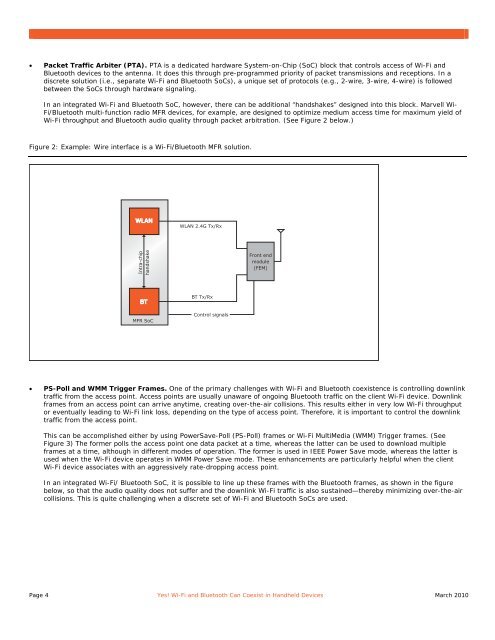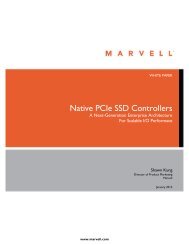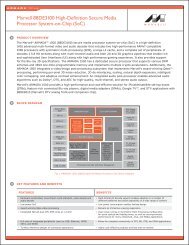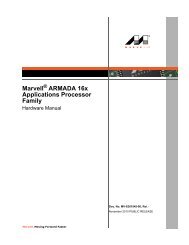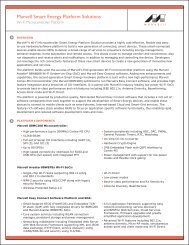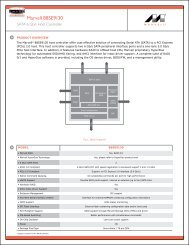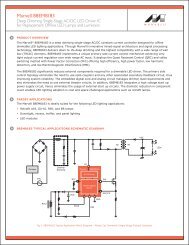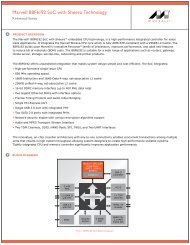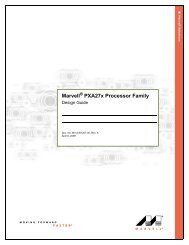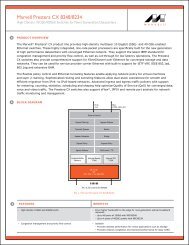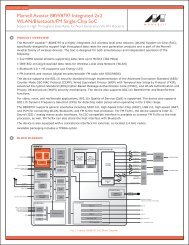Yes! Wi-Fi and Bluetooth Can Coexist in Handheld Devices
Yes! Wi-Fi and Bluetooth Can Coexist in Handheld Devices - Marvell
Yes! Wi-Fi and Bluetooth Can Coexist in Handheld Devices - Marvell
Create successful ePaper yourself
Turn your PDF publications into a flip-book with our unique Google optimized e-Paper software.
• Packet Traffic Arbiter (PTA). PTA is a dedicated hardware System-on-Chip (SoC) block that controls access of <strong>Wi</strong>-<strong>Fi</strong> <strong>and</strong><br />
<strong>Bluetooth</strong> devices to the antenna. It does this through pre-programmed priority of packet transmissions <strong>and</strong> receptions. In a<br />
discrete solution (i.e., separate <strong>Wi</strong>-<strong>Fi</strong> <strong>and</strong> <strong>Bluetooth</strong> SoCs), a unique set of protocols (e.g., 2-wire, 3-wire, 4-wire) is followed<br />
between the SoCs through hardware signal<strong>in</strong>g.<br />
In an <strong>in</strong>tegrated <strong>Wi</strong>-<strong>Fi</strong> <strong>and</strong> <strong>Bluetooth</strong> SoC, however, there can be additional “h<strong>and</strong>shakes” designed <strong>in</strong>to this block. Marvell <strong>Wi</strong>-<br />
<strong>Fi</strong>/<strong>Bluetooth</strong> multi-function radio MFR devices, for example, are designed to optimize medium access time for maximum yield of<br />
<strong>Wi</strong>-<strong>Fi</strong> throughput <strong>and</strong> <strong>Bluetooth</strong> audio quality through packet arbitration. (See <strong>Fi</strong>gure 2 below.)<br />
<strong>Fi</strong>gure 2: Example: <strong>Wi</strong>re <strong>in</strong>terface is a <strong>Wi</strong>-<strong>Fi</strong>/<strong>Bluetooth</strong> MFR solution.<br />
WLAN<br />
WLAN 2.4G Tx/Rx<br />
Intra-chip<br />
h<strong>and</strong>shake<br />
Front end<br />
module<br />
(FEM)<br />
BT<br />
MFR SoC<br />
BT Tx/Rx<br />
Control signals<br />
• PS-Poll <strong>and</strong> WMM Trigger Frames. One of the primary challenges with <strong>Wi</strong>-<strong>Fi</strong> <strong>and</strong> <strong>Bluetooth</strong> coexistence is controll<strong>in</strong>g downl<strong>in</strong>k<br />
traffic from the access po<strong>in</strong>t. Access po<strong>in</strong>ts are usually unaware of ongo<strong>in</strong>g <strong>Bluetooth</strong> traffic on the client <strong>Wi</strong>-<strong>Fi</strong> device. Downl<strong>in</strong>k<br />
frames from an access po<strong>in</strong>t can arrive anytime, creat<strong>in</strong>g over-the-air collisions. This results either <strong>in</strong> very low <strong>Wi</strong>-<strong>Fi</strong> throughput<br />
or eventually lead<strong>in</strong>g to <strong>Wi</strong>-<strong>Fi</strong> l<strong>in</strong>k loss, depend<strong>in</strong>g on the type of access po<strong>in</strong>t. Therefore, it is important to control the downl<strong>in</strong>k<br />
traffic from the access po<strong>in</strong>t.<br />
This can be accomplished either by us<strong>in</strong>g PowerSave-Poll (PS-Poll) frames or <strong>Wi</strong>-<strong>Fi</strong> MultiMedia (WMM) Trigger frames. (See<br />
<strong>Fi</strong>gure 3) The former polls the access po<strong>in</strong>t one data packet at a time, whereas the latter can be used to download multiple<br />
frames at a time, although <strong>in</strong> different modes of operation. The former is used <strong>in</strong> IEEE Power Save mode, whereas the latter is<br />
used when the <strong>Wi</strong>-<strong>Fi</strong> device operates <strong>in</strong> WMM Power Save mode. These enhancements are particularly helpful when the client<br />
<strong>Wi</strong>-<strong>Fi</strong> device associates with an aggressively rate-dropp<strong>in</strong>g access po<strong>in</strong>t.<br />
In an <strong>in</strong>tegrated <strong>Wi</strong>-<strong>Fi</strong>/ <strong>Bluetooth</strong> SoC, it is possible to l<strong>in</strong>e up these frames with the <strong>Bluetooth</strong> frames, as shown <strong>in</strong> the figure<br />
below, so that the audio quality does not suffer <strong>and</strong> the downl<strong>in</strong>k <strong>Wi</strong>-<strong>Fi</strong> traffic is also susta<strong>in</strong>ed—thereby m<strong>in</strong>imiz<strong>in</strong>g over-the-air<br />
collisions. This is quite challeng<strong>in</strong>g when a discrete set of <strong>Wi</strong>-<strong>Fi</strong> <strong>and</strong> <strong>Bluetooth</strong> SoCs are used.<br />
Page 4 <strong>Yes</strong>! <strong>Wi</strong>-<strong>Fi</strong> <strong>and</strong> <strong>Bluetooth</strong> <strong>Can</strong> <strong>Coexist</strong> <strong>in</strong> H<strong>and</strong>held <strong>Devices</strong> March 2010


